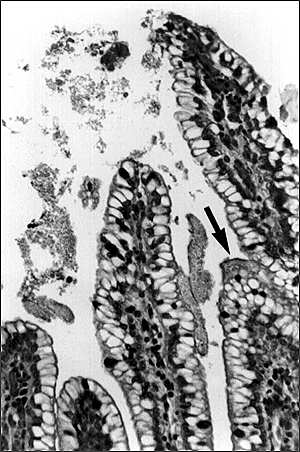Volume 4, Number 2—June 1998
Synopsis
Enteroaggregative Escherichia coli
Figure 2

Figure 2. Biofilm (arrow), containing aggregating bacteria and mucus, adhering to the mucosa of a gnotobiotic piglet fed enteroaggregative E. coli strain 042 and sacrificed after 3 days. This piglet did not contract diarrhea. (Reprinted with permission of James Nataro and Clinical Microbiology Reviews. Clin Microbiol Rev 1998;11:142-201.)
Page created: December 15, 2010
Page updated: December 15, 2010
Page reviewed: December 15, 2010
The conclusions, findings, and opinions expressed by authors contributing to this journal do not necessarily reflect the official position of the U.S. Department of Health and Human Services, the Public Health Service, the Centers for Disease Control and Prevention, or the authors' affiliated institutions. Use of trade names is for identification only and does not imply endorsement by any of the groups named above.